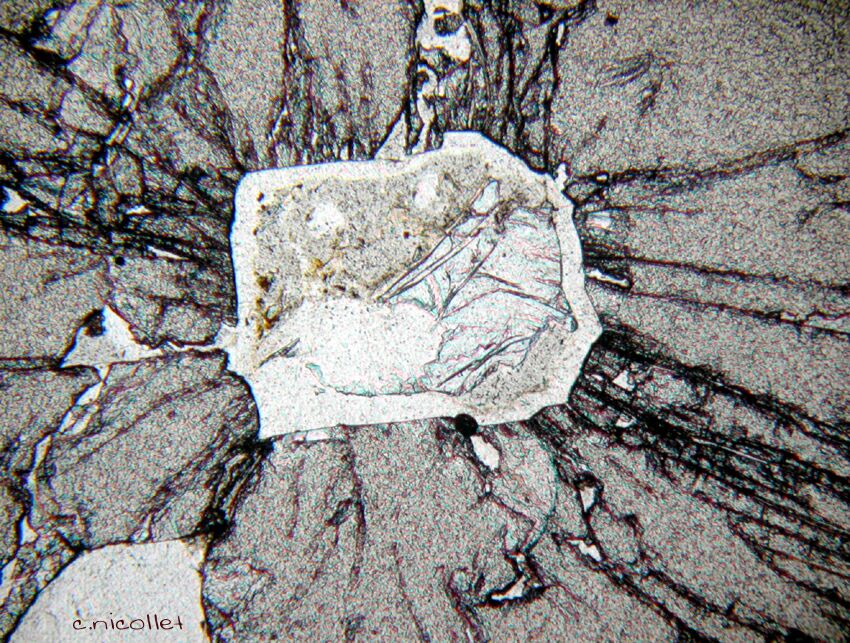
The Dora Maira Coesite or Why do metamorphic rocks recrystallize?
Why do rocks recrystallize when pressure and/or temperature (or fluids) change? To understand this, consider the coesite quartzite from Dora Maira (Italian Alps) described by C. Chopin in 1984. The occurrence in this rock of small crystals of coesite, a high-pressure form of silica, testifies to the fact that this sedimentary rock (i.e. formed on the surface) was buried up to 100km below the surface before being exhumed. The paragenesis consists of abundant quartz, kyanite (Ky), phengite (a white mica) and magnesium-rich garnet. Coesite is only found as tiny inclusions in garnet or kyanite.

In this microphotograph in plane polarised light (PPL), coesite makes small leucocratic inclusions in the garnet; radial fractures are systematically observed in the garnet around these inclusions.
Quartz and coesite are 2 minerals with different physical properties, but the same chemical composition, SiO2. Such minerals are known as polymorphs. Quartz has a molar volume of 2.27 cm3 and is stable from the earth's surface to around 100 km. Coesite, with a molar volume of 2.06 cm3, is stable at depths greater than 100 km. Beyond this depth, quartz transforms into coesite via the reaction quartz = coesite. The transformation can take place in the reverse sense during exhumation. This is precisely what we can see in the microphotographs on this page. Rising from the great depths, coesite, which constituted the majority of the rock's mineralogy, was transformed into quartz, with the exception of tiny inclusions in garnet and kyanite. In these inclusions, the coesite = quartz transformation has begun, but has come to a halt, as the transformation involves a considerable change in volume, as shown by the respective molar volumes. The onset of transformation and the resulting increase in volume are responsible for the radial fracturing of garnet.

Included in garnet, coesite is the colorless, highly refringent ("high relief") mineral associated with low-refringent ("low relief") quartz (PPL).

Tiny quartz crystals are radially arranged around the coesite: this shows that quartz forms at the expense of coesite - cross-polarized light (XPL)
Why is coesite (a small-volume mineral) transformed into quartz (a large-volume mineral) when the rock returns to the surface? We know that the density of rocks increases from the surface towards the center of the globe (with the exception of the low-velocity zone beneath the lithosphere).This increase in density means that the volume of a rock decreases when it is buried at depth (= P increases) and vice versa when it is exhumed. The rock, made up of crystals of one or more mineral species, is compressed. Minerals, however, are not very compressible.Consequently, the reduction in volume resulting from a significant increase in pressure can only be partially offset by mineral compression.In this way, low-density, large-volume minerals, stable at the surface are replaced by denser, small-volume minerals at depth.
As a general rule, rocks are polymineral, and the reactions that allow them to change volume as a function of depth (= pressure) involve several minerals : A +B=C+D with V (C-D)<V (A -B) ; V is the volume. The change in volume of the reaction is negative when the assemblage of minerals A+B is replaced by assemblage C+D, and is accompanied by an increase in pressure.
The same line of reasoning can be used to explain the role of temperature on metamorphic recrystallization. When a cold surface rock sinks into a hot globe, a heat exchange DQ takes place between the warming rock and its surroundings. In rock, Q and T increase by DQ and DT and, as a result, the DQ/DT ratio is positive.. This ratio is called DS, variation of entropy S. It measures the entropy variation DS between the entropy of the "hot" rock and that of the "cold" rock. If this ratio is positive as T increases, this means that the entropy of the hot rock is greater than the entropy of the cold rock. But what is entropy? It is not just a mathematical ratio, but an inherent characteristic of minerals. Entropy is the number of ways in which atomic and molecular constituents can be distributed in a mineral (entropy is also said to measure disorder). The number of possible combinations in a mineral is not infinite. Actually, entropy of the minerals varies a very little. So when a rock is raised to high temperatures, its entropy increases. As the entropy of the minerals that make it up varies little, low-temperature minerals are replaced by high-temperature, high-entropy minerals.
These transformations take place during intermineral reactions such as: A +B=C+D with S (C-D)>S (A -B). The entropy variation of the reaction is positive when the C-D mineral assemblage replaces the A-B assemblage, and is accompanied by an increase in T.
![]() Back to the PhotoGallery, to the Metamorphism Course or else to the Home Page ?
Back to the PhotoGallery, to the Metamorphism Course or else to the Home Page ?